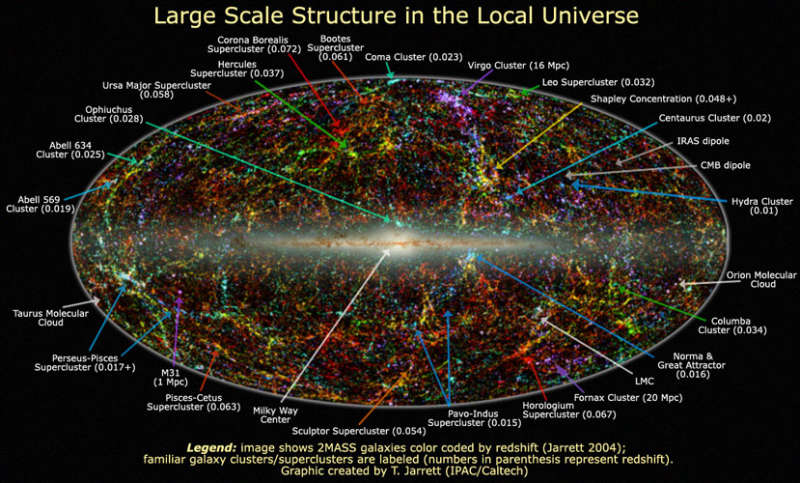Credit & Copyright: 2MASS,
T. H. Jarrett, J. Carpenter, & R. Hurt
Explanation:
What does the universe nearby look like?
This plot shows over one and a half million of the brightest stars
and galaxies in the nearby universe detected by the
Two Micron All Sky Survey
(2MASS) in infrared
light.
The resulting image is an
incredible tapestry of stars and galaxies that
provides limits
on how the universe formed and evolved.
Across the center are stars that lie in the
plane of our own
Milky Way Galaxy.
Away from the Galactic plane, vast majority of the dots are
galaxies, color
coded to indicate distance, with blue dots representing the nearest
galaxies in the
2Mass survey,
and red dots indicating the most distant survey galaxies that lie at a
redshift near 0.1.
Named structures
are annotated.
Many galaxies are
gravitationally bound together to form
clusters,
which themselves are loosely bound into
superclusters, which in turn are sometimes seen to
align over even larger scale structures.
1999 2000 2001 2002 2003 2004 2005 2006 2007 2008 2009 2010 2011 2012 2013 2014 2015 2016 2017 2018 2019 2020 2021 2022 2023 2024 2025 |
Yanvar' Fevral' Mart Aprel' Mai Iyun' Iyul' Avgust Sentyabr' Oktyabr' Noyabr' Dekabr' |
NASA Web Site Statements, Warnings, and Disclaimers
NASA Official: Jay Norris. Specific rights apply.
A service of: LHEA at NASA / GSFC
& Michigan Tech. U.
|
Publikacii s klyuchevymi slovami:
galaxies - universe - krupnomasshtabnaya struktura Vselennoi - galaktiki
Publikacii so slovami: galaxies - universe - krupnomasshtabnaya struktura Vselennoi - galaktiki | |
Sm. takzhe:
Vse publikacii na tu zhe temu >> | |
